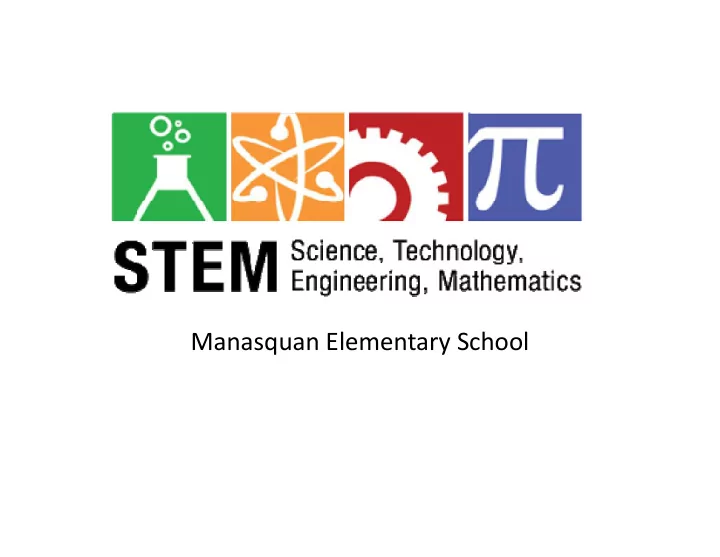

Manasquan Elementary School
What is STEM ? • STEM education is the re‐visioning of science education to enable the next generation of innovators. • STEM education is the preparation of students in competencies and skills in the four disciplines of science, technology, engineering, and mathematics. • STEM is a range of instructional strategies that help students apply concepts and skills from the four different disciplines to participate in a “design process” to solve meaningful problems.
STEM is not … • A curriculum • A “packaged program” • Subject areas taught in isolation • Activities with step‐by‐step directions • Teacher demonstrations • An “add‐on” to the current program
STEM DISCIPLINES • SCIENCE: Study of the physical and natural world through observation and experimentation • TECHNOLOGY: Work involving designing, testing, maintaining, and improving computer software, hardware, systems and networks; connects people through communication; involves making problems easier to solve • ENGINEERING: Work involving developing systems, structures, products, and materials; uses the design process to solve real‐world problems • MATH: Uses numerical, spatial, and logical relationships to study and solve problems as the foundation for science, engineering, and technology
The Difference? • Science, math, and technology naturally relate to one another for subject area integration …. STEM now adds the ENGINEERING component • Students are encouraged to participate in the Design Process : Identify the problem or challenge – ASK! Brainstorm for solutions ‐ IMAGINE ! Design and research ‐ PLAN! Build a model ‐ CREATE! Test and evaluate – TIME TO REFLECT! Make adjustments ‐ IMPROVE!
STEM includes enhanced STEM education …. opportunities in: Encourages creativity Critical thinking Creates problem solvers Hands on inquiry Supports communication and Problem solving collaboration Real life applications Produces critical thinkers Creativity Offers students challenging and engaging Cooperative learning content Trial and error (There is more than one right answer!) Connects classroom learning to the real Integrated subject areas world Open‐ended activities Evidence‐based reasoning Data analysis / measurement / probability
In a STEM activity, learning often comes from failures …… Why didn’t it work? What can you do about it?
Why STEM? STEM workers are the innovators and inventors! Necessary to prepare young Americans to succeed in a global society Plays a critical role in our nation’s future economic prosperity and competitiveness Growing demand across all industries for new products and inventions is fueling the need for STEM workers Occupations related to STEM are projected to grow to more than one million by 2022 (U.S. Bureau of Labor Statistics) STEM is for ALL students! Early exposure to STEM initiatives can pique student interest in engineering and other STEM career paths
New Jersey’s Initiatives Raised the bar in mathematics and language arts literacy with the adoption of the updated New Jersey Learning Standards Focus to a new vision for science education – with the adoption of the Next Generation Science Standards & STEM Education initiatives
NEXT GENERATION SCIENCE STANDARDS (NGSS) Based on the Framework for K‐12 Science Education developed by the National Research Council Collaboratively written by partnering teams from: National Research Council National Science Teachers Association American Association for the Advancement of Science Improves the quality of science teaching Provides essential preparation for success in the modern workforce
Our Goals at MES Summer 2015 : Revise K‐8 Science Curriculum to align to the Next Generation Science Standards & include STEM initiatives at EVERY grade level Develop and pilot an Accelerated STEM Program for identified Seventh Grade students during the 2015‐2016 school year Summer 2016 : Make updates to the new curriculum – and develop an Accelerated STEM Program for Eighth Graders for the 2016‐2017 SY Summer 2017 : Curriculum planning for STEM ….to Integrating the Arts!
ACCELERATED GRADE 7 STEM PROGRAM INITIAL IDENTIFICATION: Final averages in Mathematics, Science, Language Arts, Social Studies, and Technology PARCC Scores (Lang Arts & Math) STEM Placement Test MAP Scores (Lang Arts & Math) Cognitive Abilities Test IDENTIFIED STUDENTS: Required application with essay FINAL REVIEW OF APPLICANTS: STEM Committee will review applications/essays, grades, and Placement Test scores Final Approval by the Building Administration for acceptance into the program
ACCELERATED GRADE 7&8 STEM PROGRAM Extends Extends the curriculum in science, mathematics, and technology education to include rigorous enrichment activities and experiences with an engineering approach Provides opportunities to participate in lessons that require increased increased critical thinking and problem solving skills Exposes students to more advanced more advanced lessons that encourage them to investigate, model, and explain the natural and designed world through an integrated curriculum
VISION and MISSION STATEMENT Manasquan Elementary School: “ Preparing Tomorrow’s Innovators ” We We believe that encouraging critical and creative believe that encouraging critical and creative thinking through a thinking through a STEM instructional approach will STEM instructional approach will prepare our students for prepare our students for the future workforce. the future workforce.
STEM STEM …. where the jobs of tomorrow will be! where the jobs of tomorrow will be! A message from college students about STEM ….. https://www.youtube.com/watch?v=zgB‐Diy8imo
STEM Committee Elyse Boyes, Kindergarten Rob Markovitch, Middle School Science Kali Mura, First Grade Laura Wahl, Middle School Science Donna Mead, Second Grade Marc Reid, Middle School Math Krissy Sliwoski, Third Grade Andy Manser, Middle School Math Brianna O’Hara, Fourth Grade Kirt Wahl, Technology Education Amelia Gliddon, Fifth Grade Mark Levy, Technology Education Oriana Kopec, Media Specialist
Recommend
More recommend